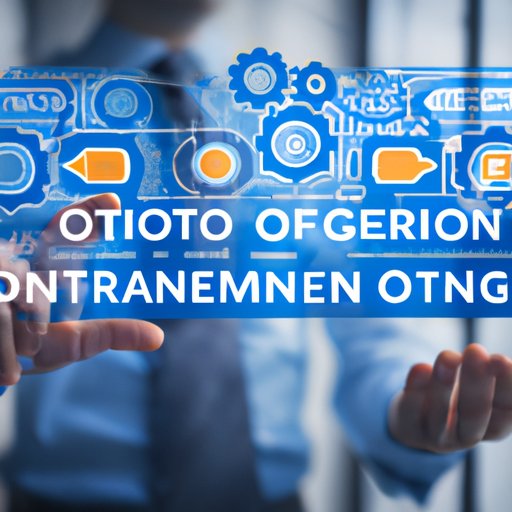Introduction
Operational technology (OT) is a term that encompasses the hardware and software used to automate industrial processes. It enables organizations to monitor, control and optimize the performance of their production systems and operations. As such, OT has become an essential component of modern business operations, allowing companies to make quick, informed decisions about their production processes.

Exploring the Basics of Operational Technology: A Comprehensive Guide
In order to understand the role of OT in automation and digital transformation, it is important to first explore the basics of this technology. This includes understanding its definition and terminology, types of OT and examples of OT.
Definition and Terminology
The term “operational technology” is used to describe the hardware and software used to control and monitor physical processes, such as manufacturing, energy generation, and water and waste management. These systems are designed to collect data from sensors and other sources, process it and then send commands to equipment or machines to execute various tasks.
Types of OT
Operational technology can be divided into two broad categories: wired and wireless. Wired OT systems use cables and wires to connect devices, while wireless OT systems rely on radio signals or Wi-Fi to communicate. Additionally, there are two main types of OT systems: closed-loop and open-loop. Closed-loop systems are designed to operate autonomously and require minimal human intervention, while open-loop systems allow for more direct control from operators.
Examples of OT
Operational technology can be applied to a variety of industries and applications. Common examples include industrial robots, programmable logic controllers (PLCs), distributed control systems (DCSs), supervisory control and data acquisition (SCADA) systems, and manufacturing execution systems (MES). These systems enable businesses to better monitor and manage their production processes, ensuring quality and efficiency.

The Benefits and Challenges of Implementing OT in Your Business
When considering implementing OT in your business, it is important to understand the potential benefits and challenges associated with this technology. By understanding these factors, you can ensure that your organization gets the most out of its OT investments.
Benefits
The primary benefit of OT is its ability to increase operational efficiency. This is achieved by automating repetitive tasks and reducing manual labor, which can result in cost savings. Additionally, OT systems can provide real-time insights into production processes, enabling businesses to quickly identify and address any issues that arise. Finally, OT systems can help ensure safety and security, as they can detect and respond to potential threats before they cause harm.
Challenges
Despite the benefits, there are some challenges associated with implementing OT in your business. The most common challenge is the cost of purchasing and maintaining the necessary hardware and software. Additionally, OT systems can be complex and require a certain level of technical expertise to operate and troubleshoot. Finally, OT systems may require frequent updates to keep up with changing standards and regulations.

Understanding the Role of OT in Automation and Digital Transformation
OT plays an important role in the automation and digital transformation of businesses. Automation refers to the process of using technology to reduce or eliminate manual labor, while digital transformation involves the adoption of digital technologies to improve customer experience, streamline processes and increase efficiency. By leveraging OT, businesses can achieve both of these goals.
Overview of Automation and Digital Transformation
Automation and digital transformation are key components of any successful business strategy. Automation can help reduce costs by eliminating manual labor, while digital transformation can help businesses stay competitive by improving customer experiences and streamlining processes. Both of these strategies can be achieved through the use of OT.
Role of OT in Automation and Digital Transformation
OT plays an important role in automation and digital transformation. By leveraging OT systems, businesses can automate tedious tasks, allowing them to focus on more strategic initiatives. Additionally, OT systems can gather data from various sources and provide real-time insights into the performance of production processes. This data can then be used to optimize operations and improve customer experiences.
Analyzing the Impact of OT on Industrial Efficiency, Safety and Security
The use of OT can have a significant impact on industrial efficiency, safety and security. By leveraging OT systems, businesses can improve their efficiency by automating tedious tasks and collecting data to identify and address any issues that arise. Additionally, OT systems can enhance safety and security by detecting and responding to potential threats before they cause harm.
Increasing Efficiency
The use of OT can help businesses increase their efficiency by reducing manual labor and automating tedious tasks. Additionally, OT systems can provide real-time insights into production processes, enabling businesses to quickly identify and address any issues that arise. This can ultimately lead to cost savings, improved customer satisfaction and increased profitability.
Enhancing Safety and Security
OT systems can also help businesses enhance safety and security. By leveraging sensors and other technologies, OT systems can detect and respond to potential threats before they cause harm. This can help ensure the safety of workers and prevent costly accidents or disruptions.
Examining the Future of OT and the Opportunities Ahead
As OT continues to evolve and new technologies emerge, there are a number of exciting opportunities ahead. Emerging technologies such as artificial intelligence (AI) and the Internet of Things (IoT) are opening up new possibilities for OT, while existing technologies can be used to further optimize operations and ensure safety and security.
Emerging Technologies
Artificial intelligence and the Internet of Things are two emerging technologies that are revolutionizing the way businesses operate. AI can be used to automate complex tasks and provide predictive analytics, while IoT can be used to collect and analyze data from connected devices. By leveraging these technologies, businesses can further optimize their operations and gain valuable insights into their production processes.
Potential Applications
There are many potential applications for OT. For example, OT systems can be used to automate and optimize industrial processes, such as manufacturing and energy production. Additionally, they can be used to monitor and control safety and security systems, such as fire alarms and access control systems. Finally, OT systems can be used to provide real-time insights into production processes, enabling businesses to quickly identify and address any issues that arise.
Conclusion
In conclusion, operational technology (OT) is a powerful tool for automating industrial processes and optimizing operations. By leveraging OT systems, businesses can increase their efficiency, enhance safety and security, and gain valuable insights into their production processes. Additionally, emerging technologies such as AI and IoT are opening up new possibilities for OT, while existing technologies can be used to further optimize operations. Understanding the role of OT in automation and digital transformation is essential for any business looking to stay competitive in today’s market.
Summary
This article provided an overview of what operational technology (OT) is and how it is used in automation and digital transformation. It explored the basics of OT, including its definition and terminology, types of OT and examples of OT. Additionally, it discussed the benefits and challenges of implementing OT in your business, as well as the role of OT in automation and digital transformation. Finally, it examined the impact of OT on industrial efficiency, safety and security, as well as the future of OT and the opportunities ahead.
Final Thoughts
As businesses continue to embrace automation and digital transformation, understanding the role of OT is essential. By leveraging OT systems, businesses can increase their efficiency, enhance safety and security, and gain valuable insights into their production processes. Additionally, emerging technologies are opening up new possibilities for OT, while existing technologies can be used to further optimize operations. In order to stay competitive in today’s market, it is important for businesses to understand the power of OT and the opportunities it presents.
(Note: Is this article not meeting your expectations? Do you have knowledge or insights to share? Unlock new opportunities and expand your reach by joining our authors team. Click Registration to join us and share your expertise with our readers.)
